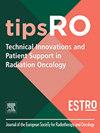纹身在乳腺癌再照射中的可靠性评价
IF 2.8
Q1 Nursing
Technical Innovations and Patient Support in Radiation Oncology
Pub Date : 2025-08-22
DOI:10.1016/j.tipsro.2025.100338
引用次数: 0
摘要
背景纹身有助于指导乳房再照射的部位放置。本研究评估了既往乳房放疗(RT)患者内侧纹身的稳定性,以确定其作为表面标记物的可靠性。材料和方法回顾性研究了2022年1月至2023年12月期间在我院接受过乳房/胸壁再照射(RT2)和既往乳房放疗(RT1)的患者。两个RT课程的计划ct使用严格的图像配准进行注册。在CT1和CT2上勾画内侧纹身、胸骨和胸腔内血管的内部穿孔分支,并将poi放置在各自的中心,以评估移位和3D距离,报告为目标配准误差(TRE)。结果本组患者18例,胸骨三维三维立体扫描平均为0.8 mm(SD0.8),在CT体素厚度范围内。平均内侧纹身3D TRE为9.2 mm(SD5.4)。在两次扫描之间手臂位置不同的患者中,观察到明显更大的3D TRE(相同:4.7 mm vs不同:10.9 mm, p = 0.002)。在RT2前进行乳房切除术的患者中观察到最大的3D TRE为22.1 mm。血管三维TRE平均为4.1 mm (SD2.3),受臂位影响(差异= 4.4 mm vs相同= 2.9 mm, p = 0.009)。结论:由于手臂定位和手术方式的改变会随着时间的推移影响体表解剖结构,单纯依靠以前的内侧纹身作为以前RT野界的指标可能不准确。再现患者的原始设置和手臂的位置是必要的,以减少在乳房再照射登记错误。如果改变手臂位置是不可避免的,胸腔内穿支血管可以提供更强健的定位。本文章由计算机程序翻译,如有差异,请以英文原文为准。
Evaluation of tattoo reliability in breast cancer re-irradiation
Background
Tattoos help guide field placement in breast re-irradiation. This study evaluates the stability of medial tattoos in patients with prior breast radiotherapy (RT) to determine their reliability as surface markers.
Materials and methods
We retrospectively identified patients who had breast/chest wall re-irradiation between January 2022 and December 2023 (RT2) and prior breast RT (RT1) at our institution. Planning CTs for both RT courses were registered using rigid image registration. The medial tattoo, sternum, and internal perforating branches of the internal thoracic vessels were contoured on both CT1 and CT2, and POIs were placed at the respective centers to assess shifts and 3D distances reported as target registration errors (TRE).
Results
Eighteen patients were included, average sternum 3D TRE was 0.8 mm(SD0.8), within CT voxel thickness. The average medial tattoo 3D TRE was 9.2 mm(SD5.4). Significantly greater 3D TRE was observed in patients whose arm positions varied between scans (Same: 4.7 mm vs Different: 10.9 mm, p = 0.002). The largest 3D TRE was 22.1 mm, observed in a patient who had a mastectomy before RT2. The average vessels 3D TRE was 4.1 mm (SD2.3) and impacted by arm position (Different = 4.4 mm vs Same = 2.9 mm, p = 0.009).
Conclusion
Relying solely on previous medial tattoos as indicators of the previous RT field border can be inaccurate due to arm positioning and surgical procedure changes that impact surface anatomy over time. Reproducing the patient’s original setup and arm positioning is essential to reducing registration errors in breast re-irradiation. If varying arm positions are unavoidable, internal thoracic perforator vessels may provide more robust registration.
求助全文
通过发布文献求助,成功后即可免费获取论文全文。
去求助
来源期刊

Technical Innovations and Patient Support in Radiation Oncology
Nursing-Oncology (nursing)
CiteScore
4.10
自引率
0.00%
发文量
48
审稿时长
67 days
 求助内容:
求助内容: 应助结果提醒方式:
应助结果提醒方式:


